



The Education Column
Andrew Harmsworth with the latest Education news
This month I take a close look at something that has been used for many years in primary schools: MyWorld. Developer ClicSoft has been producing additional educational resources for MyWorld and Textease for a number of years now, so we take a closer look at what they have to offer. There's even a prize CD on offer to the first person to email me the correct answer to a teasing question!
Stop Press! In the process of writing this article, I discover that Textease can now do bullets...
Their World
MyWorld has been around for years. Its beauty has always been that it is an environment for learning, rather than simply an educational program which remains limited to how it was when you first bought it.
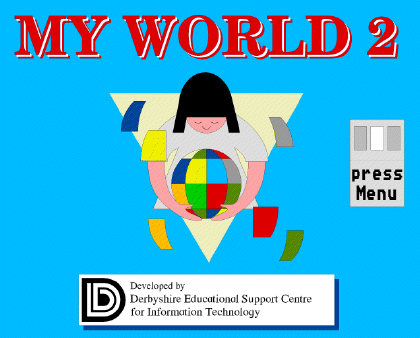
Fig. 1: MyWorld's Start-up Screen
MyWorld is one of those applications that began life on the RISC OS platform, then spread its wings elsewhere. Fortunately the whole MyWorld experience is based around the DrawFile format so anything newly developed for MyWorld on the PC is of use to RISC OS users. What is even better is that Softease added a MyWorld filter to Textease some time ago, so you can even run the activities without the MyWorld application itself. That said, Textease can only run as part of the desktop, whereas MyWorld defaults to full screen, which may be less distracting for some pupils.
Clicsoft
According to the Clicsoft website, Clic is an acronym for "Cynhaliaeth liwgar i'r cwricwlwm" which is Welsh for "Colourful support for the curriculum" and they certainly live up to that name. In business for 4 years this month since owner Gaynor Perry retired from teaching, they are leading developers of MyWorld and Textease support screens for Primary education.
It's reassuring to know that educational software you are considering purchasing has had at least some input from an established educator. Gaynor certainly brings all her years of experience to the fore in her numerous resources. Let's take a closer look.
Early Years
The Foundation Stage (as it is now known*) for 3-5 year olds, has four packs of screens available: sizes, colours, shapes and shadows. Clicking on the correct object, in response to a question, leads pupils on to progressively more complex tasks including biggest/smallest, shortest/tallest, highest/lowest, etc.
* Being a physicist, I like to call it Key Stage Zero
Key Stage One (KS1)
For pupils aged 5-7 (or, as Gaynor suggests, for second-language learners) Houses and Their Contents can be looked at, as well as The Body. These tasks are more sophisticated including labelling and recognition activities where the correct response move the learner on to a new task.In addition to these, early maths support is available for counting, time-telling, addition and subtraction. As part of the science series (see below), screens for Life Processes, Physical Processes and Homes & Houses are available.
Key Stage Two (KS2)
The Science Series supports KS2 with the following:- Humans as Organisms
- Green Plants as Organisms
- Living Things in their Environment
- Materials and their Properties
- Electricity and Power
- Forces and Motion
The Science Series
Drawing heavily on Gaynor's former career as a science teacher, Clic have 9 sets of screen supporting science teaching at KS1 and KS2. Let's take a look at Life Processes (biology to the rest of us) at KS1:
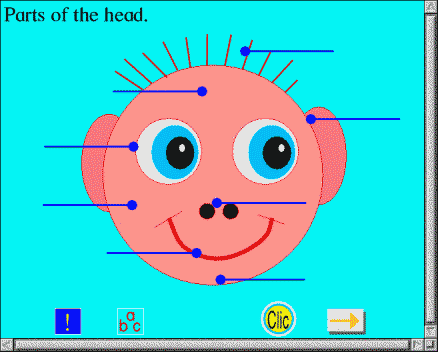
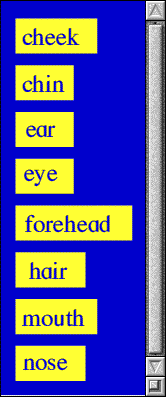
Fig. 2: Labelling Parts of a Head
Pupils can call up a list of words by clicking on the abc icon. It is then a simple matter of dragging them to the appropriate location on the screen. MyWorld has the facility to save partly-completed screens. However, in order to go back to them and continue, saved screens must be stored in the same location as the original - otherwise word lists or other linked-to pages cannot be found.
One advantage of using Textease as the environment for MyWorld screens is that you can add text to the resulting image. Note my imaginative addition of my name to the completed head below (Harmsy is highlighted due to Textease's spell checker - this would not be present on printing).
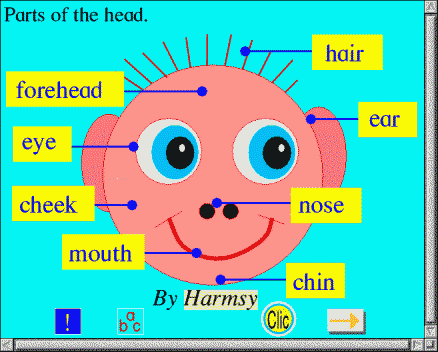
Fig. 3: A Fully-Labelled Head
A more advanced task involves labelling parts of the body. This could even be used at KS3 or (perish the thought!) KS4 (GCSE to the rest of us) as body parts don't change their positions (other than a gradual increase in altitude):
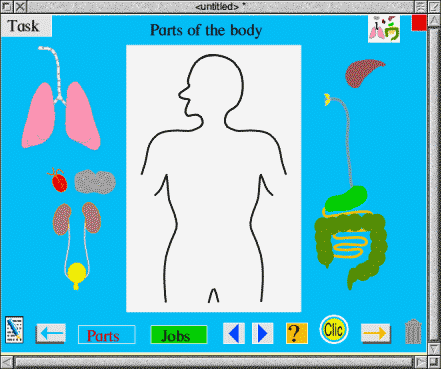
Fig. 4: Where do I put this?
Clicking on the Task icon tells you what to do: move the parts to the right place, then label them. In case you're not quite sure what each image is, clicking on the body parts icon give you labelled versions:
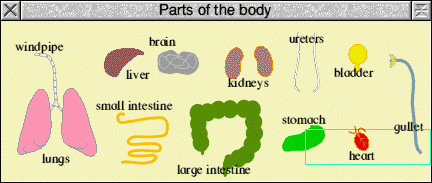
Fig. 5: What your bits are
For such complex tasks, labels may be too big to fit together. In this case, MyWorld can decrease or increase the size of labels if they're dragged to the arrows in the middle. Here's a work in progress that demonstrates this rather well:
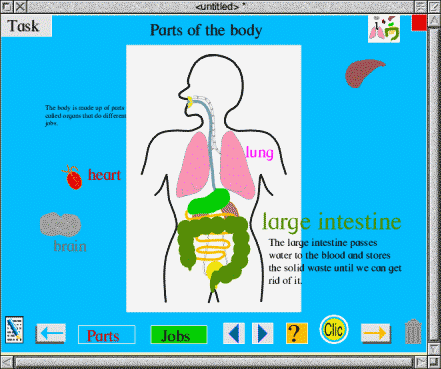
Fig. 6: Getting there...
Note that the text alongside the large intestine is included as part of the available information - in other words, pupils could re-use the task many times when studying the function of different body systems. Versatile, quick, easy and always a pleasing result.
In Conclusion...
Available in English and Welsh versions, Clicsoft have a large collection of excellent resources for Primary education. Each pack costs £30 + VAT which is very reasonable given the time and effort that is required to create them. The more complex tasks offer a wide range of uses and as such I am very pleased to be able to give the whole collection the RISC World stamp of approval.

Competition Time!
Gaynor has given RISC World a copy of the RISC OS version of the MyWorld/Textease Science Series. This could be yours if you answer this simple question:
What does CLIC stand for?
Email your answer, together with your name and address, to: rwcomp@harmsy.freeuk.com and the first person's email to be read (amongst the hundreds of spam messages) will find the CD on its way!
Contacts
Clic, Bwthyn y Glyn, Nant Y Garth, Y Felinheli, Gwynedd. LL56 4QB
email: gaynor@clicsoft.co.uk website: www.clicsoft.co.uk
Textease Bites the Bullet
Just as this article was due to go to email (rather than press, you see) I discovered something that I'd never seen in the Textease manual (and have just checked - it's not there!) - Textease can do bullets!
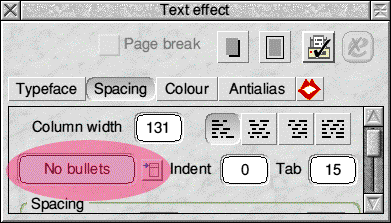
Fig. 7: Is it me?
Of course, my fiancé says that she's known about this for ages... meanwhile I've steered clear of using Textease for some worksheets for this very reason...
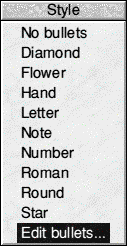
Fig. 8: Textease's configurable bullet list
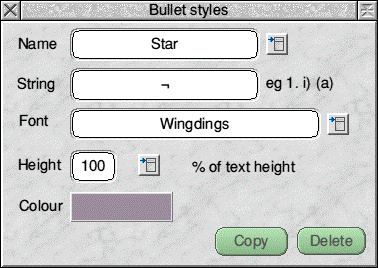
Fig. 9: Textease's Bullet Playing-with Menu
No prizes, but could anyone tell me what version number this feature came in? I just wish Softease would publish details of the changes they make in each new version... happy bulleting!
If you have any questions or comments on the use of RISC OS computers in education, please either email education@harmsy.freeuk.com or better still join the RISC OS Education Discussion List, and air them there.
Andrew Harmsworth